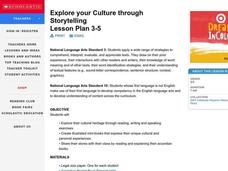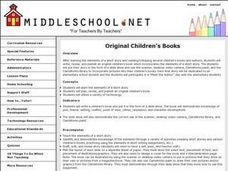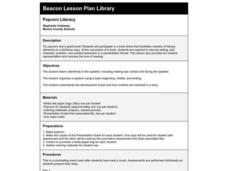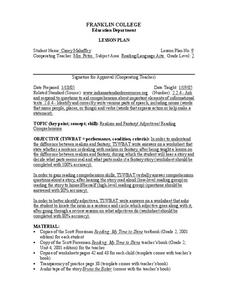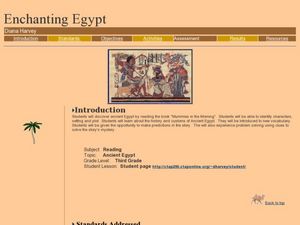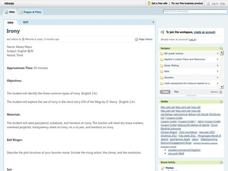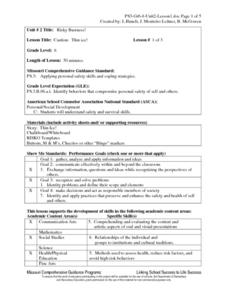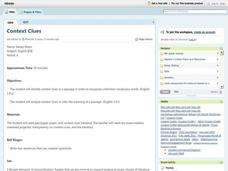National Endowment for the Humanities
Toni Morrison's Beloved: For Sixty Million and More
Complex, disturbing, and challenging, Beloved is the focus of a lesson that provides three activities to guide a close reading of Toni Morrison's novel. Readers create chapter titles based on key plot elements or themes, identify...
Curated OER
Explore your Culture through Storytelling
Explore the cultural heritage through of your class through reading, writing, and speaking exercises. They create illustrated mini-books that express their unique cultural and personal experiences. They share their stores with the class...
Curated OER
Call of The Wild
Prompt your class to interact with Jack London's Call of the Wild. By analyzing the events in the novel, middle schoolers discover how human experiences create who a person becomes. They critique and analyze the reading, focusing on...
Curated OER
Original Children's Books
Bring the fun and creativity of children's stories to your language arts class. Middle schoolers write, revise, and publish an original student book which incorporates the elements of a short story. They put their story in the form of a...
Curated OER
Summarizing Key Information
Imagine the surprise when small groups present their Evidence Charts to the class and discover that each group has studied a different version of the Cinderella story. Irish, Ojibwa, Egyptian, Chinese, Korean, Persian, Mexican, and...
Curated OER
Fairy Tales
Students listen as the teacher reads fairy tales to students and identify patterns. They listen as the teacher re-reads the fairy tales and signal or recite patterns as they listen. Students identify patterns in the fairy tales. They...
Marion County Schools
Popcorn Literacy
Popcorn is a tasty part of a culminating activity designed to motivate readers to share important literary elements. The popcorn fills the inside of a white paper bag that is transformed on the outside into a presentation tool with the...
Curated OER
Patterned Leaf Cloths
Students identify and reproduce simple patterns (e.g., red blocks alternating with blue blocks; clap-clap-stamp) and create and extend simple patterns using a variety of materials or actions (e.g., popsicle sticks, pebbles, stickers,...
Curated OER
Realism and Fantasy
Second graders listen to the story, Bruno the Baker, where some parts seem real and some seem fake. They must identify the parts of the story as realism or fantasy. An interesting way to teach young readers these two concepts.
Shmoop
ELA.CCSS.ELA-Literacy.RL.11-12.2
There is nothing more frustrating than discussing theme in literature, and now the Common Core requires that your learners determine two or more, and discuss the development of it throughout the text. This is crazy, but manageable with...
Curated OER
Big Dog and String-bean
Match and read, what could be more fun? Learners read a story and identify pronouns in the text. They read the text again and correctly match pronouns to nouns on a worksheet. Great introductory activity.
Curated OER
Enchanting Egypt
After reading the Magic Tree House book Mummies in the Morning, learners talk about Ancient Egypt. They identify the plot, characters, setting, etc., explore vocabulary terms, and construct a pyramid. This will motivate your class to...
Curated OER
Word Problem Exchange
Learners discuss elements of word problems: key words, data, computation clues, and unnecessary information and use the four steps of problem solving to find a solution and check for reasonableness.
Pyro Innovations
Reading Comprehension
Good reading practices can start at any age. Early readers work with the teacher to read a short story about a bear. First, they identify basic text features, such as the title, author, and illustrator. Then, they answer several simple...
Curated OER
A Sailing We Will Go!
Fifth graders investigate the journey that Magellan took around the world. Small groups conduct research on a ship that went on Magellan's voyage, write the story of their ship, and create a class dance that demonstrates the route taken...
Curated OER
Irony
What are the three types of irony? High schoolers engage in a lesson about the use of irony while reading O.Henry's short story "Gift of the Magi." They'll discuss rising action, climax, and resolution in the text before highlighting the...
Curated OER
Sally's Super Day
Second graders engage in a lesson that is about having a super day with an example of a fictitious child. They read "Sally's Super Day" and reflect upon the events and how they affected the character and the outcome of the story. The...
Curated OER
Caution: Thin ice!
Sixth graders listen to story and respond with comments or questions. They brainstorm unsafe behaviors and randomly fill out templates with different risky behaviors listed on the board. They play RISKO, the Bingo type game.
Curated OER
Lesson Plan 2: So What's a Novel, Anyway?
What makes a novel a novel? Class members select a favorite novel, record their impressions on a worksheet, and then come together in groups to discuss the elements common to narrative writing. Next, they identify the characters, the...
Curated OER
Stone Soup
First graders examine the use of logic, deduction, and inference to determine the answers to riddles. They listen to a teacher read aloud of Heather Forest's, Stone Soup before discussing the story which gauges their comprehension....
Curated OER
Putting On Armor
Seventh graders are read the story "EMS Code Blue" and asked to share what they would do in the different situations. As a class, they discuss the importance of getting help for mental or social problems and are given a list of resources...
Curated OER
Using Dreams in Writing
C.S. Lewis’s That Hideous Strength provides the model for using dreams in narrative writing. After a discussion of the purpose of dreams in Lewis’s tale, class members craft a story in which their dreams play an essential role.
Curated OER
Context Clues
Work on context clues with your ninth graders in this lesson, which focuses on identifying and analyzing clues to define unfamiliar words. They identify context clues in a passage to recognize words they haven't seen before, and then...
Curated OER
A Walk Around the School: Mapping Places Near and Far
After reading Pat Hutchins’ Rosie’s Walk, have your young cartographers create a map of Rosie’s walk. Then lead them on a walk around the school. When you return class members sequence the walk by making a list of how the class got from...



